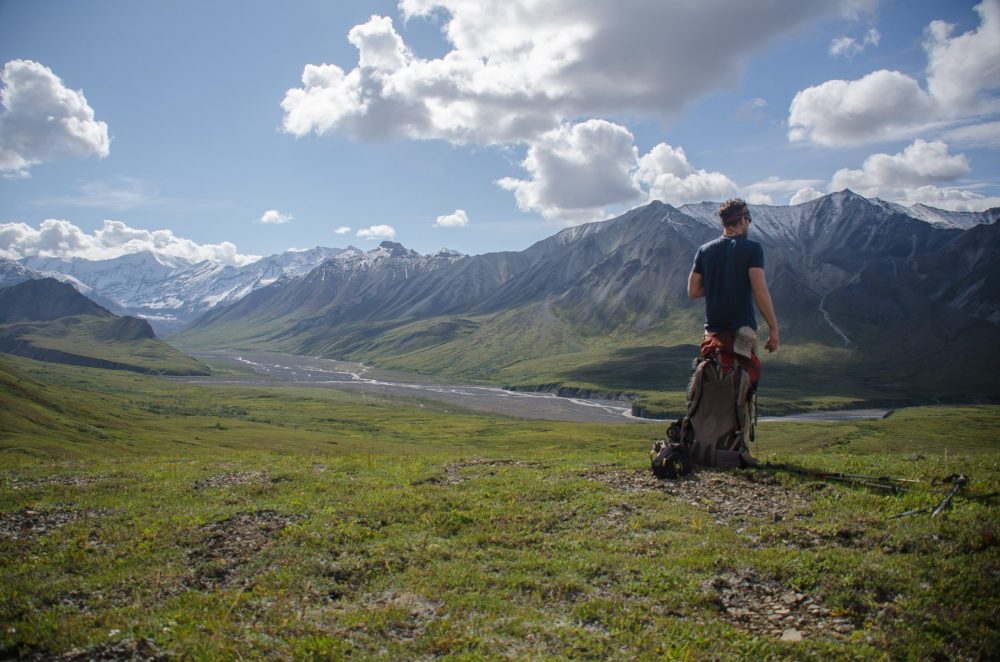If someone were to ask me which American National Park is the wildest, I would say Denali National Park. First of all, it is in the State of Alaska, which automatically makes it wild, then there are the other factors that help it to solidify this designation in my book like it protects 6 million acres of wilderness, almost entirely without roads and it contains North America’s highest mountain, Denali, the only mountain in North America over 20,000’at 20,310. Lastly, what makes Denali wild is the large Grizzly bear population. It is hard to imagine visiting Denali without seeing one of the massive bears and in the back country you will almost certainly have multiple encounters with them, and you have to be mentally prepared for how you will react to seeing one especially if you are charged.
Denali is one of my favorite backpacking destinations. In the backcountry tundra there are no trails or designated campsites. It is pure wilderness trekking and hikers are entirely responsible for themselves because there is no one to help you in the backcountry if you get into trouble.
The wilderness is protected by a strict permit system and by the lack of access to the back country. The road into Denali national park is off-limits to private vehicles and visitors can only enter via bus. This heavily restricts the visitor numbers and trekkers. Trekkers then get off at various entry points into the wilderness depending on their permit.
I was fortunate that my brother Jesse worked in the park for approx. decade and had priority access to permits, camping equipment and was very knowledgeable about the backcountry. This presented me a great opportunity to visit Jesse and do some trekking and I visit him twice in Denali, July 2008 and July 2015 and on both occasions we did at least 3 days of backcountry trekking. The trekking was some of the wildest I have ever done. These are the stories and photos from my backcountry treks in Denali.

Location of Denali
Getting to Denali meant flying into Fairbanks or Anchorage and taking a train or taxi shuttle. Once in the visitor’s center to Denali, I would meet Jesse and we would travel into the park via the bus or a park vehicle that he had special access to. The drive into Denali was incredible and started in lower forested elevations where moose, and elk are common. As you travel further into the park the elevation rises and becomes more mountainous and tundra like. Views of the massive Denali Mountain are in view now if you are lucky enough to have clear skies. This is also where grizzly bear country begins, and the grizzle become very common. Then there is always the chance of seeing a wolf, caribou, and countless other animals.

Denali Mountain

Moose-are very dangerous and hard to spot until you are right near them in the forest. They are prone to charge and can cripple or kill you. One ofJesse’s friends was charged by one and broke his leg.

Young Elk

Massive Caribou

Coyote
In my 2008 trip during the weekend of the 4th of July, I was joined by Jesse and my friend Matt. We hiked from Unit 10 to 11 in the park crossing over several mountains in steep scree slopes. In early July the sun doesn’t set, so we hiked until midnight until we realized we were tired and needed to sleep. My brother, who was responsible for the tent, accidentally packed a one-man tent for the three of us, but luckily for the first night of camping it didn’t rain and there were no mosquitos in the high tundra, so I was able to sleep halfway outside of the tent. of course, we were in bear country and having half your body exposed in bear country at night is never a good idea. But the one-man tent would be a huge problem for us the next night when we camped at Wonder Lake which was known to have clouds of mosquitos and truly is one of the most mosquito infested places I have ever been. To add to the nightmare, it rained hard and all three of us had to sleep with our bodies entirely in the tent. We were packed like sardines into the tent, and we had to take turns sleeping on our sides because there wasn’t enough room to lay flat on our backs. Then mosquitos were so bad they were biting us through the tent. It was one of the worst sleeping experiences I have ever had.

Crossing rivers into the muntains

Hiking scree slopes

Hiking scree slopes

Hiking scree slopes
Carrying bear spray in an easily accessible canister attached to your waist is a must when in the Denali backcountry. This grizzly was off to our side but was more interested in eating roots than in us and we walked right by as swiftly as possible.

Hiking scree slopes

Matt, me and Jesse with denali in the background

Wonder Lake

The three of us sleeping in a one man tent in the rain in the mosquito infested Wonder lake
My 2nd trip to Denali was in late July 2015 I stayed longer in Denali and this time my Jesse had a cabin near Eilsen where I stayed my first and last night in Denali. From his cabin we could see herds of Dahl sheep in the high alpines of the mountains nearby. From Eilsen, Jesse and I hiked two nights from the visitor center to Divide pass and to castle Rock, where we camped and then on to Anderson Pass. The hike was long, crossed multiple rivers up to our waist in freezing water, scree slope and tundra. From our campsite we observed at least 3 giant grizzly bears grazing on berries only a few hundred yards away from us. As is always the case when backpacking in Denali, we never saw another person.

Flowers were blooming in the tundra

Midnight sun in tundra

Rainbow

Crossing the river bed

My brother the mountain man of Denali

View from our campsite at midnight

Angry marmot
Jesse and I camped on top of castle Rock, a huge tundra viewpoint overlooking Denali and glaciers all around us. This is all wild camping. We were alone miles and miles away from anyone and from our campsite we could see massive grizzly bears grazing on berries only a few hundred yards away. There was no escaping grizzly’s here. All we could do was cook and store our food far from our tents, keep our bear spray handy and be vigilant. In late July, the sun set and there was darkness for approx. 4 hours every night which meant that grizzly bears could enter our camp unseen during this time. As an extra defense I kept a knife near my pillow and my hiking poles sticking out towards any potential intruders of the night.

Our two tents in our campsite with a glacier in the background and grizzly bears grazing on berries not far away

Scanning the backcountry
Our campsite was also full of ground squirrels which made their anger towards us very loudly known. Anything left outside including hiking poles was a potential victim to the little tireless gnawing teeth of these little guys. Ground squirrels are also a favorite treat of grizzly bears.

Ground squirrels

Me admiring the view

From our campsite we kept an eye on this large grizzly which might be the largest grizzly I have ever seen

Our campsite

Our perch where we ate, cooked and stored our food upwind from the bears and far from our campsite

Grizzly that ran through our campsite chasing ground squirells
After hiking to Anderson pass, we returned to our tents still fortunately intact and not ransacked by bears and squirrels. We spent one more night camping and the next morning right when we just returned from our perch and determined the bears were far away and it was safe to take our tents down, right in the middle of packing up camp a grizzle came running at full speed towards us. It was a surreal experience. The moment we feared was unfolding before our eyes and it took a moment to react. The bear veered away at the last moment and jumped off the ledge. We were relieved but perplexed. Did the bear just commit suicide, where did it go? We crawled over the ledge to get a better look and saw the bear below on the slope pouncing on ground squirrel holes and trying to hunt them. The bear looked up at us and made eye contact fora moment but was more interested in the squirrels and let us pack up our camp and leave in peace.

